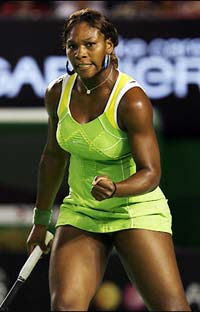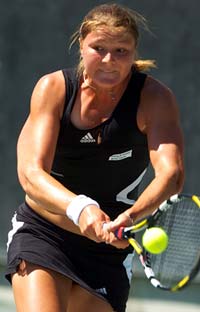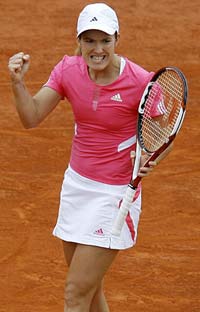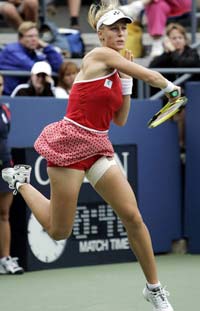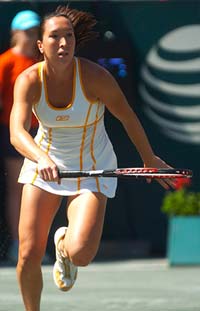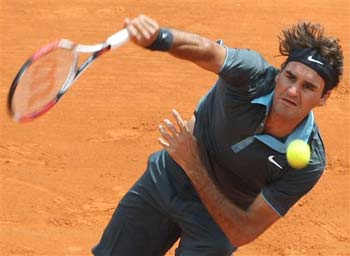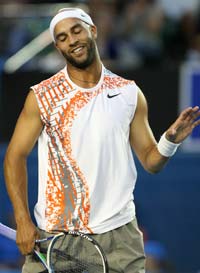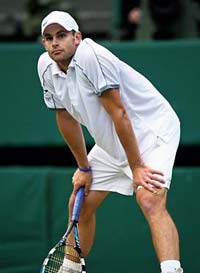|
TennisOne Lessons Who Will Win the French Open? Paul Fein In early May, proud and prickly Serena Williams declared: “We all know who the real number one is. Quite frankly, I’m the best in the world.” Holder of the 2008 U.S. and 2009 Australian titles, Serena was dismissing the flawed WTA Tour ranking system that awarded Dinara Safina the No. 1 ranking. But she was also indirectly dismissing and diminishing Safina.
The 23-year-old Russian had spent years in the shadow of her older brother Marat, a two-time Grand Slam champion, and wasn’t going to take this slight lying down. “I don’t care about those critics,” she fired back. “I am not here through luck. I had an unbelievable run from last April. I won four tournaments. I played in two Grand Slam finals, and the final of the Olympic Games. I think this is enough to become No. 1.” But talk is cheap. Since Serena’s semi-cheap shot, she hasn’t won a match, going down to No. 95 Klara Zakopalova, No.20 Patty Schnyder and No. 45 Francesca Schiavone (retiring after losing the first set because of her chronic knee injury) in first-round debacles. Meanwhile, Safina indisputably made her case for the No. 1 ranking − on the courts. With growing confidence, she reeled off a 14-1 record on European clay. She gained the Stuttgart final, captured Rome with victories over Venus Williams and Svetlana Kuznetsova, and then won Madrid by easily disposing of rising Danish star Caroline Wozniacki.
“For me it’s tennis first: tennis, tennis and tennis; I don’t do anything besides tennis,” says all-business Safina, a late-bloomer who is ready and more than able to seize her first Grand Slam title at Roland Garros. She was outplayed 6-4, 6-3 by Ana Ivanovic in last year’s final, but will benefit from that learning experience. The void left by the shocking May 2008 retirement of Justine Henin is biggest on the terre battue in Paris where the gifted Belgian earned four of her seven major titles. The absence of proven clay court standouts will increase Safina’s chances. She also is located in the weaker half of the draw with only No. 9 Victoria Azarenka, an aggressive 19-year-old Belarusan, posing a genuine threat. But Safina owns a 3-1 career record against Azarenka. Safina is scheduled to meet No. 8 Ivanovic in the quarterfinals, but assorted injuries (thumb and knee, especially) and the inability to handle high expectations have stymied the beautiful, ever-smiling Serb. Seldom has a defending champion seemed so unlikely to repeat. In six tournaments this season, Ivanovic has advanced past the quarters only once, when she made the finals on hard courts at Indian Wells. While her French title in 2008 was certainly no fluke, the 6’1” heavy hitter lacks the requisite speed, agility, topspin, consistency, and court savvy for clay domination. My crystal ball predicts that Safina, a sturdy 5’11 ½”, 154-pounder, will prevail because of her relentless power game. Her picture-perfect two-handed backhand, quite similar to former No. 1 Lindsay Davenport’s, ranks as one of the most devastating weapons in women’s tennis. While she lacks the athleticism and versatility of Henin or the explosive serve of Serena and Venus, she plays the percentages well, controls her once-fiery temper and has no stroke weaknesses.
Most impressive of all, Safina has a burning desire to make tennis history like her brother. (They became the first tennis brother and sister to rank No. 1 in the world.) Before Stuttgart, she said, “I am ready for the challenge of defending my No. 1 position. I am a woman on a mission.” The Contenders That mission will be challenged by one of five contenders in the bottom half of the draw. Supremely talented Serena covets a second title in Paris, the only Slam event she hasn’t won at least twice. Her recent poor results and knee problems give her two question marks. Also on the minus side, 27-year-old Serena’s powerful shotmaking is blunted somewhat on slow clay, and she’s lost some of the blazing speed she flashed during her 2002-2003 prime. All that said, if she survives the first week (she was upset in the third round last year) and gains momentum, muscular Serena can still beat anyone on any surface. Wozniacki, a genial and comely blonde 18-year-old, is steadily improving and could break through at Roland Garros. She won Ponte Vedra Beach and reached the final at Charleston and Madrid, all on clay, while knocking off No. 4 Elena Dementieva twice. Wozniacki has a solid all-around game without a super weapon, much like Jankovic, and the two could meet in the round of 16 with the winner likely to face Dementieva in the quarters.
Jankovic finished 2008 ranked a controversial No. 1 because she failed to win a major title, while Serena hurt her cause by competing in only 13 tournaments. The effervescent Serb lacked a knockout punch so she underwent a grueling off-season training program that included high-altitude work in Mexico. While she gained strength and bulk, she lost vital speed. (Michael Chang tried the same experiment in the 1990s and failed for the same reason.) Jankovic hasn’t beaten a top 10 player in nine events and has advanced past the quarters only twice. Even so, her high-percentage game and defensive skills make her a contender. Dementieva, now 27 and still seeking her first Grand Slam title, won something last year she considers even more important: a gold medal at the Beijing Olympics where she defeated Serena, Vera Zvonareva and Safina. Afterwards, the 5’11” Russian said, “My next goal is: yes, I want to become No. 1 in the world, and I know I can do it.” Dementieva has reached three straight Slam semifinals and hit a career-high No. 3 in April. If she gets to the final, she’ll have to handle the pressure better than she did in her dismal 6-1, 6-2 French final loss to compatriot Anastasia Myskina in 2004. She’s a fighter and has overcome her self-destructive serving woes, so she can’t be counted out. If Safina doesn’t win the title at Roland Garros, I predict No. 7-ranked Kuznetsova will. A chronic underachiever since capturing the 2004 U.S. Open at age 19, Kuznetsova shows signs of harnessing her high-powered shots and athleticism this year. She whipped Dementieva and Safina to take Stuttgart, and a week later took out Jankovic and Azarenka to make the Rome final. Kuzy has weapons galore: a big first serve and the best kick second serve on the tour, a rocket forehand, and an increasingly aggressive backhand that denies opponents a chance to breathe. The best women’s match of the fortnight could feature a heavyweight duel between Kuznetsova and Serena in the quarterfinals. Dangerous Floaters: Kateryna Bondarenko, Alexa Glatch, Li Na, Akgul Amanmuradova.
The Men Can anyone beat Rafael Nadal at Roland Garros? So far, all opponents have bitten the dust, or rather the salmon-hued clay, where Nadal, like a ferocious body puncher, pummels them until they succumb. Andy Roddick likens the experience of facing Nadal’s vicious forehand to “Chinese water torture.” Roger Federer, thrice a losing finalist to Nadal in Paris, bluntly confides, “I don’t have a problem on clay. I have a Rafa problem on clay.” Federer’s respect for his arch rival is such that he even acknowledges that Rafa could achieve a rare Grand Slam: “With the great record Rafa has at the French, and he comes in with incredible confidence for the grass, he definitely has a shot to do it this year.” If feeling the agony of defeat first-hand isn’t demoralizing enough, contenders and pretenders can ponder the awesome numbers proving Nadal’s dominance. In four French Opens, the Spanish matador stands a perfect 28-0. Last year, ever-improving Nadal didn’t surrender a set and thrashed Federer 6-1, 6-3, 6-0 in the quick final. For those who think they can outlast Nadal, he’s 43-0 during his career in best-of-five-set matches on clay. Not since legendary Bjorn Borg, champion here in 1974-75 and 1978-1981, has anyone reigned so masterfully. And Rafa is aiming to break Borg’s record of four straight titles this fortnight. The Mighty Fed also harbors a burning desire to break a far more famous and hallowed record: Pete Sampras’s career mark of 14 Grand Slam titles. A Roland Garros triumph would not only tie Fed with Pistol Pete but end the GOAT (Greatest of All Time) Debate because it would give Federer his first major title on clay, a feat Sampras failed to achieve. Of course, if Federer fails in Paris, he can still get No. 14 a month later at Wimbledon, where he was dethroned last year but still owns five crowns, or at the U.S. Open, where he’s also a five-time titlist.
Nadal has suffered only two losses on clay in the past 17 months − to Juan Carlos Ferrero last year and to Federer 6-4, 6-4 in the 2009 Madrid final for the Swiss’s only title this season. While Federer admitted the upset gave him “a huge boost” in confidence, he was helped by the high altitude and fast courts and Nadal’s being worn out from a brutal, four-hour marathon semifinal against Novak Djokovic. Before Madrid, Nadal had defeated Federer five straight times. Federer’s two other main rivals are also tightening the vice on the 27-year-old Swiss. No. 3 Andy Murray has knocked off Fed four consecutive times, and No. 4 Djokovic has whipped Fed twice in a row. Nadal turns 23 on June 3, while Murray and Djokovic turned 22 in May. This ambitious triumvirate keeps improving, while Federer often seems less like a superstar and more like a mere mortal these days. The day before Federer lost a heartbreaking five-set Australian Open final four months ago, he gave an astonishing answer when asked if he relished another crack at arch rival Nadal. “Honestly, I preferred the days when I didn’t have a rival.” One can’t imagine Jimmy Connors, John McEnroe, Steffi Graf or Monica Seles or any great champion and competitor ever making that statement.
The fast, light balls plus a favorable French Open draw up to the semifinals clearly help Federer. Hot, dry weather would also boost his chances because his offensive weapons, a strong serve and versatile forehand, thrive in fast conditions. Americans Roddick and James Blake, who have won an abysmal 10 matches combined at Roland Garros in their careers, shouldn’t trouble Federer, but dangerous Frenchmen Gael Monfils and Jeremy Chardy might. If Djokovic gets by extremely dangerous No. 5 Juan Martin Del Potro, a 6’6” big banger with superb technique, in a likely quarterfinal, he’ll probably face Federer in what should be a toss-up semifinal. The Djoker lost to Nadal here in the quarters in 2006 and semis in 2007 and 2008 and displayed his smarter, improved clay game when he had three match points against Rafa in their Madrid marathon. Taking the ball on the rise, he prevented Rafa from overwhelming him during backcourt rallies. Although Murray trained on Spanish clay for 2½ years as a teenager, it remains his least successful surface. That said, the analytical Scot (who frequently studies videos of his opponents) is steadily improving and reached the semis in Monte Carlo and quarters in Madrid. His cagey change of pace, outstanding strokes, defensive skills and ability to attack give him lots of potential on clay. But, like Djokovic, the question lingers whether Murray is tough enough both mentally and physically to win five-set matches against Nadal, or even Federer, on clay and especially in hot weather.
If Nadal, a prohibitive (1-3) favorite, were to be upset, the rest of the Big Four
aren’t surefire bets to take the title. Del Potro, only 20, has matured since Federer annihilated him 6-3, 6-0, 6-0 in a disheartening Australian Open quarterfinal. The lanky Argentine upset Nadal 6-4, 3-6, 7-6 in Miami and overpowered Murray 7-6, 6-3 in Madrid. Fernando Verdasco benefited from grueling training sessions in the Las Vegas heat last December under the supervision of Gil Reyes, Andre Agassi’s longtime fitness guru. Conversations with Reyes and Agassi also inspired the talented lefty to start fulfilling his potential at the Australian Open. There the 25-year-old Verdasco, whose punishing game closely resembles Nadal’s, bumped off Murray and 2008 finalist Jo-Wilfried Tsonga before pushing Nadal to the limit in a sensational 6-7, 6-4, 7-6, 6-7, 6-4 semifinal. If he and Nadal meet in the quarters, it should be another heavy-hitting thriller. Nicolay Davydenko, a French semifinalist in 2005 and 2007 and a top 5 player for the past four years, boasts topnotch groundstrokes off both sides, a surprisingly fast serve for his 5’10”, 154-pound physique, and superb stamina. The colorless but hard-working Russian would like nothing more than to be remembered for a major title rather than a match-fixing allegation that was dropped. When the dust settles in the late afternoon on June 7, King Rafael will still be ensconced on the French throne. Aside from an improved but not explosive serve, high-energy Nadal possesses a near-perfect game for clay. Defensively, his speed, smart shot selection, and passing shots are unparalleled. Offensively, he’s complemented his ferocious forehand and strong backhand with a highly competent net game that usually wins 70 percent of the points on approaches as well as better positioning near the baseline. If all those assets aren’t formidable enough, his supplementary shots − smashes, lobs and drop shots − also excel. But Rafa is separated from the field by the hunger and humility he displays in his never-ending quest to be the best he can be. Serena Williams, in her eloquent tribute to Nadal in TIME magazine’s “The World’s 100 Most Influential People” issue, captured those admirable traits when she wrote: “I have never seen such tenacity, such ambition, such fight and such honor go into every shot as when I watch Rafael Nadal.” Dangerous Floaters: Juan Monaco, David Ferrer, Yen-Hsun Lu, Jeremy Chardy. Your comments are welcome. Let us know what you think about Paul Fein's article by emailing us here at TennisOne.
Paul Fein Paul Fein, a USPTA teaching pro and former top 10-ranked New England men’s open player, has won more than 20 writing awards. His 2002 book, Tennis Confidential: Today’s Greatest Players, Matches, and Controversies, published by Brassey’s, Inc., was listed No. 1 among tennis books by Amazon.com and BN.com. Information about the book and how to order it can be found at www.tennisconfidential.com. His second book, You Can Quote Me on That: Greatest Tennis Quips, Insights, and Zingers, was published by Potomac Books, Inc. (formerly Brassey’s, Inc.) in 2005 and was listed No. 1 among tennis books by Amazon.com and BN.com. For more information, visit www.tennisquotes.com. His third book, Tennis Confidential II: More of Today’s Greatest Players, Matches, and Controversies, was published April 28, 2008 and was featured on the home page of Amazon.com. |

